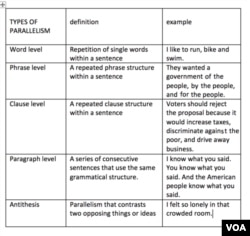Parallelism is the repetition of similar grammatical forms. It is a powerful tool in public speaking and writing.
You may have heard this quote attributed to Julius Caesar:
I came, I saw, I conquered.
The repetition of I followed by a verb makes this an example of parallel structure. Parallelism helps make an idea or argument clear and easy to remember. It also shows that each repeated structure is of equal importance. And, it is a powerful tool for public speaking.
Throughout history, many famous leaders have used parallel structure to communicate with the public. Here is a famous saying by Abraham Lincoln:
You can fool all the people some of the time, and some of the people all the time, but you cannot fool all the people all the time.
Lincoln repeats people and time in all three clauses. But he changes the order of the words some and all. The 28-word quotation is easy to memorize because of its rhythm and parallel structure.
Antithesis
One common type of parallelism is called antithesis. Antithesis simply means the “opposite” of something. Let’s take a look at the first two lines of the Charles Dickens novel A Tale of Two Cities.
It was the best of times, it was the worst of times, it was the age of wisdom, it was the age of foolishness . . .
Notice how Dickens uses pairs of opposite words: best and worst; wisdom and foolishness. Writers and poets have long used antithesis to show the paradoxical – or opposing – nature of life.
English poet John Milton contrasted heaven and hell in this passage from Paradise Lost:
The mind is its own place, and in itself can make a heaven of hell, a hell of heaven.
“I Have a Dream”
Some of the most famous speeches in history also have examples of parallelism.
Martin Luther King fought for racial equality in the United States in the 1950s and 60s. In 1963, he gave an unforgettable speech on the National Mall in Washington, D.C. King and his supporters were pushing the U.S. Congress to pass a civil rights law. In his famous “I Have a Dream” speech, King uses several forms of parallel structure to communicate an uplifting message. Listen for repetitions and opposites.
I have a dream that one day on the red hills of Georgia the sons of former slaves and the sons of former slave owners will be able to sit down together at a table of brotherhood. I have a dream that one day even the state of Mississippi, a state, sweltering with the heat of injustice, sweltering with the heat of oppression, will be transformed into an oasis of freedom and justice. I have a dream that my four little children will one day live in a nation where they will not be judged by the color of their skin but by the content of their character. I have a dream today.
In the speech, King made many contrasts. King contrasts the sons of slaves and the sons of slave owners. Those were the people who made up most of his audience that day. He also contrasts heat with oasis, and injustice and oppression with freedom and justice.
The speech led to major changes in U.S. laws. Congress passed the Civil Rights Act the following year, which outlawed racial discrimination.
Parallelism in Academic Writing
Parallel structure is a useful tool for student writers. College professors expect a student paper to have a thesis statement. A thesis statement is a one-sentence summary of a paper’s main argument. A first-year student might write something like this:
Proposal X is not good.
A better thesis, using parallel structure, might look like this:
Voters should reject Proposal X because it is unfair to minorities, impossible to enforce, and unnecessary.
In this parallel thesis statement, the writer has set up a series of three adjectives: unfair, impossible, and unnecessary. These three adjectives can organize the structure of the entire paper — with one section for each adjective. A strong parallel thesis statement makes it easier for students to organize their thoughts and write their papers.
Problems with Parallelism
English learners and native speakers alike have difficulty with parallelism. Some writers mix different grammatical structures. For example,
I like running, biking and to swim.
The gerunds running and biking are mixed with the infinitive to swim. The mix breaks the rhythm of parallel structure. This is known as false parallelism. A better choice, then, is to use three gerunds in a series.
I like running, swimming and biking.
Another option is to use three infinitives in a series.
I like to run, to swim and to bike.
Let’s look at an example of a more complex sentence.
My supervisor asked me to write my report quickly, in way that is accurate and he also wants plenty of details.
To improve this sentence, try to use a series of adverbs ending in –ly. Do not be too attached to the original words. Here is an improved version of the sentence:
My supervisor asked me to write my report quickly, accurately, and thoroughly.
The original phrase “with plenty of details” was changed to “thoroughly” with no change in meaning. The change creates a smooth series of three adverbs ending in –ly.
Keep in mind that most people do not use long parallel structures in casual conversation. It would sound a bit unnatural and overly formal. But in writing and speeches it is hard to go wrong with parallel structure. It is the best way to make your writing more concise, clear, and memorable.
I’m John Russell.
I’m Ashley Thompson.
And I’m Adam Brock.
["Turn, Turn, Turn" by The Byrds]
A time to gain, a time to lose
A time to rend, a time to sew
A time for love, a time for hate
A time for peace, I swear it's not too late
Adam Brock wrote this article for VOA Learning English. Ashley Thompson was the editor.
____________________________________________________________
Words in This Story
parallelism – n. the use of successive verbal constructions in poetry or prose that correspond in grammatical structure, sound, meter, meaning, etc.
attribute – v. to say that (something) is because of (someone or something)
clause – n. a part of a sentence that has its own subject and verb
antithesis – n. the state of two things that are directly opposite to each other
contrast – n. to compare (two people or things) to show how they are different
paradoxical – adj. a statement that seems to say two opposite things but that may be true
sweltering – adj. very hot
oasis – n. an area in a desert where there is water and plants
thesis statement – n. a statement that someone wants to discuss or prove
false parallelism – n. the incorrect use of successive verbal constructions
concise – adj. using few words : not including extra or unnecessary information
gerund – n. an English noun formed from a verb by adding -ing
infinitive – n. the basic form of a verb preceded by to









